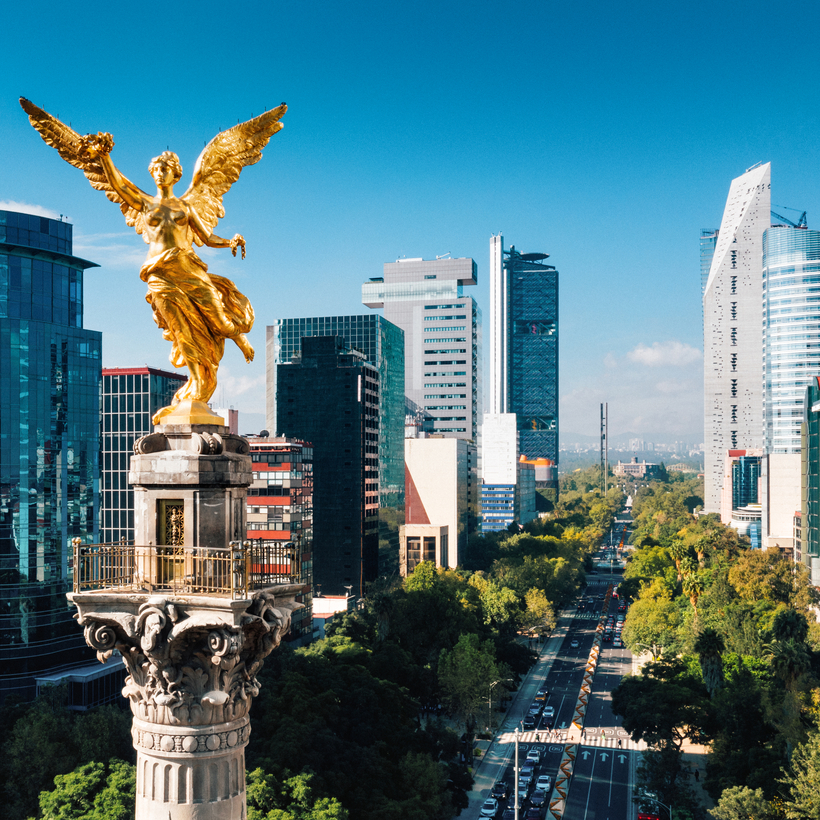One of the silver linings of being labeled the crime capital of the world is that, 20 years on, the reputation lingers just enough to dissuade wary travelers. What’s left are visitors looking for adventure, novelty, and authenticity: the Mexico City expat crowd in a nutshell.
Before the turn of the 21st century, Mexico’s capital was known for being dirty, dangerous, and violent, for tourists as well as locals. Pollution levels were among the world’s highest. In 1997, the shooting of two German visitors at the restaurant they were dining in made international headlines. That same year, an American journalist was shot in the spine during a kidnapping gone wrong. In 1998, the U.S. State Department warned that crime in Mexico City “had reached critical levels.”
Today it’s transformed. While other cities in Mexico take three of the top five slots for the world’s highest murder rates (Acapulco and Tijuana among them), Mexico City has calmed down, drug cartels have started to go elsewhere, and culture has come swooping in.
“We’ve never had more friends moving here,” a young Italian-Argentinean couple who has lived in the city since 2015 tells me. “From feeling like we were out of the way, now we’re at the center of the world.”
The bustling, 8.9 million–strong metropolis is quickly becoming the place for art, design, fashion, and nightlife, recalling at once the Marrakech of 30 years ago and the Naples of today. Its street scenes—kids and dogs running around outside 19th-century buildings—are begging for black-and-white treatment (which they got, in 2018, with Alfonso Cuarón’s dazzling Oscar winner Roma, set in Mexico City’s Roma neighborhood).
In the Zone
It was the art world that opened the floodgates. Over the last two decades, low prices and a rich history have attracted a new generation of contemporary artists. Visitors fly in from all over the world for Zonamaco, the yearly art fair founded in 2002.
This year, an “art week,” on through this weekend across the city’s galleries, replaces the traditional fair. The focus is on the local Mexico City scene. Featuring works by Haegue Yang, Gabriel Orozco, and James Benjamin Franklin, Zonamaco is now considered an artsier alternative to mainstream—and postponed, canceled, or moved-online—staples Frieze and Art Basel.
Galleries, from American curator Chris Sharp’s understated Lulu, showing Costa Rican painter Federico Herrero, to the edgy Kurimanzutto, which represents Vietnamese artist Danh Võ, and Galería Mascota, of Wolfgang Tillmans fame, have cropped up across the city’s most up-and-coming neighborhoods: Roma, La Condesa, Polanco, San Rafael.
The reigning ethos is to redefine what art is: Kurimanzutto’s first show was held in a vegetable market, while Lulu sits behind a tattered white wall, its name scrawled casually in cursive red lettering.

Design experts, meanwhile, are drawing inspiration from the region’s local artisans. Mexican artist Fernando Laposse makes textiles out of the discarded husks of heirloom corn. Other designers have started collaborating with the Oaxacan weaving community to create rugs and textiles.
“From feeling like we were out of the way, now we’re at the center of the world.”
Food has followed the path of art in Mexico City: new but with strong ties to its ancestry. Mexican chef Enrique Olvera put fine cuisine on the map in 2000 with Pujol, whose sleek dining room with floor-to-ceiling windows opened to rave reviews in Polanco. Olvera’s refined tacos inspired a new breed of restaurateur: young, adventurous, and Mexican through and through, such as Dulce Patria’s Martha Ortiz, who fuses art and gastronomy at the Alcobas hotel, and Máximo’s Eduardo “Lalo” Garcia, whose tacos are made with Wagyu beef.
At Contramar—the Mexican equivalent to Venice’s Harry’s Bar—guests meet around white tablecloths on Friday afternoons, sipping carajillos until nightfall. Hordes of waiters hover nearby, ready to brush wayward crumbs off the table.

Sushi restaurants with AAA-grade fish and extensive omakase menus are tucked away on side streets.
An Expats’ Haven
The coronavirus has only cemented Mexico City’s allure. Young people suddenly allowed to work from anywhere in the world chose the Mexican capital, joining the local population, which averages, astoundingly, just 27 years of age. And with Europe and the U.S. maintaining strict travel protocols even as they start to reopen, Mexico City is a haven for expats—a cosmopolitan corridor for friends from across the globe to get together.
For Europeans wanting to enter the U.S., Mexico City has become the go-to option for an extended layover. And no P.C.R. test is required for entry. “It’s easier to get to Mexico City than it is to travel to Mallorca,” a Spanish friend tells me. And for Americans who are missing Europe, a four-hour flight to Mexico transports them to another world—one that hails to its ancient times.
Airbnbs across the city are fully booked and full of foreigners. Edoardo Lato, the manager at Pujol, says the restaurant is seeing more young, international visitors than ever before.
And while some are using the city as a stop on the way elsewhere, many expats have preferred to settle down there. After living in New York for six years, the Spanish-Mexican designer Andrea de la Torre Suárez took a job at the late Mexican architect Luis Barragán’s Mexico City house, now a museum, where she met a local artisan willing to produce her bags and accessories. She started a brand with her sisters and called it Aurelia. Six months later, de la Torre was asked to be part of an exhibition at L.A.’s Hammer Museum.
Luia Corsini, an Italian artist who moved to the city recently, says, “I found a beautiful space to paint in within a week.” The community “is a mix of creatives working in architecture, art, and fashion,” Corsini says. Pietro Pasolini, an Italian friend of hers, recently opened up a studio practice next door.
And it’s not just artists: Japanese tea sommelier Yuri Yasuda and her Italian fiancé, Gabriele Corto Moltedo (the son of former Bottega Veneta owners), moved to Mexico three months ago. “I’m distributing matcha in Mexico City now,” she says. “The city is energetic.”
Nowadays, when Instagram stories are littered with shots of taco stands, sombreros, and the capital’s signature Art Deco buildings, you can’t help feeling a little out of touch if you don’t know the ins and outs of Mexico City.
Elena Clavarino is an Associate Editor for Air Mail

